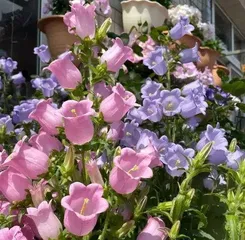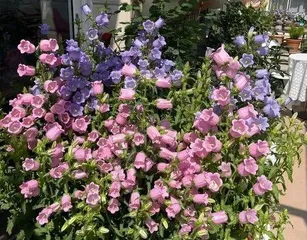Have you ever thought about planting a pot of bellflowers at your doorstep? Watching them sway in the breeze, doesn't it make your whole mood feel joyful? The name 'bellflower' itself is full of poetry. So, how do you grow bellflowers? Don't worry, let me guide you step by step into the world of growing bellflowers.
Soil: Choose the right soil for bellflowers to take root more firmly
Bellflowers are not too demanding when it comes to soil, but they can't grow in just any soil. They prefer loose, fertile, and well-draining sandy loam. Imagine if the soil was as hard as concrete, how could the roots of the bellflower take hold? Therefore, when choosing soil, you can consider mixing leaf mold, river sand, and garden soil. This way, you can ensure both the soil's fertility and its drainage capacity.
Sowing: Choose the right time for bellflowers to sprout more vigorously
The sowing time for bellflowers is actually quite flexible; it can be done all year round, but the best times are spring and autumn. The climate is suitable during these seasons, and the germination rate for bellflowers is higher. Before sowing, prepare the seeds. If the seeds are small, you can use peat boards for sowing in rows or pot sowing. The covering soil should be about 2-3 times the diameter of the seeds. After sowing, keep the soil moist, and you should see seedlings sprout in about 10-20 days.
Light: Ample sunlight for bellflowers to bloom more brilliantly
Bellflowers are sun lovers; they love plenty of sunlight but cannot tolerate strong direct light. Therefore, when planting bellflowers, choose a spot with plenty of light but avoid direct sunlight. In the summer, you can provide some shade for the bellflowers to prevent them from being scorched by the intense sun.
Water and Fertilizer: Water moderately and fertilize reasonably for healthier bellflower growth
Bellflowers prefer a moist environment but are not tolerant of waterlogging. Therefore, water moderately, just enough to keep the soil moist. As for fertilizing, you can choose organic fertilizer or compound fertilizer, applying it once a month, but be careful not to overdo it. During the growing period, also pay attention to supplementing with some trace elements, such as magnesium and calcium, so that the bellflowers can grow healthier.
Maintenance: Pruning, weeding, and pest/disease control for longer-lasting beautiful bellflowers
Bellflowers grow quickly and can easily develop messy branches and leaves, so they need regular pruning to keep the plant tidy. At the same time, be careful to weed, preventing weeds from competing with the bellflowers for nutrients and water. As for pests and diseases, bellflowers are susceptible to aphids, powdery mildew, etc., and appropriate pesticides can be used for control.
Section: Growing Bellflowers is Actually Not That DifficultHaving read this far, don't you think growing bellflowers is actually not that difficult? As long as you choose the right soil, pick the right time, ensure adequate sunlight, water moderately, fertilize reasonably, prune and weed regularly, and control pests and diseases, your bellflowers will grow strong and bloom beautifully.
So, what are you waiting for? Go plant a pot of bellflowers now and add a touch of poetry and beauty to your life!